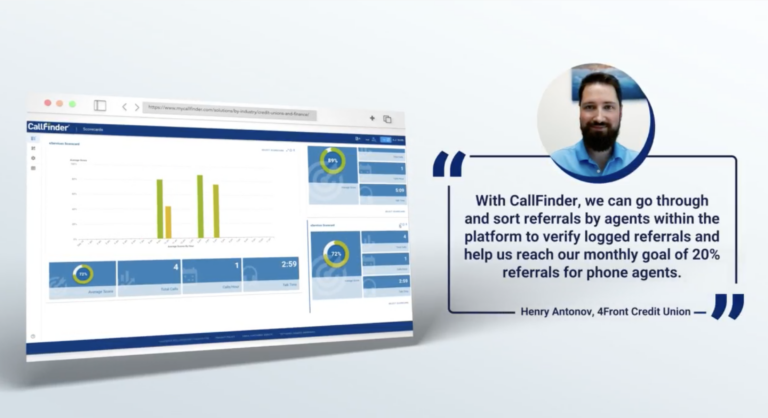Are you looking for ways to increase admissions at your crisis center? Maybe you want to reduce call handling times, or you need to monitor agents for script compliance. Or, you want an in-depth knowledge of the type of experience your clients get from agents. You can do all of this and more with call sentiment analysis.
Here are 6 ways call sentiment analysis can help your crisis center. But first, let’s look at how this feature works.
What is Call Sentiment Analysis?
For the purposes of this post, we’ll focus on CallFinder’s sentiment analysis, and the way it works is fairly simple. Our technology transcribes and scans your call recordings for specific words that imply a positive or negative sentiment. In other words, this feature quantifies the mood of a conversation.
The user-friendly dashboard provides easy, visual interpretations of the overall sentiment in 100% of your calls to provide a better understanding of agent performance. When sentiment analysis scores are compared across a selection of data points, such as a date range or agents, the insights you get can be used for a variety of benefits.
Here are a few examples of what you can uncover with sentiment analysis as part of CallFinder’s speech analytics solution:
- Gaps in agent training
- Trends in caller complaints
- Script compliance issues
- Deeper understanding of KPIs
1. Cut Your QA Time in Half
According to our research, contact center managers save up to 20% of valuable time each week with speech analytics software. That time was previously spent searching through hundreds of phone calls each week just to find the ones that might contain relevant metrics. But a comprehensive speech analytics solution with call sentiment analysis does the heavy lifting for you.
CallFinder’s sentiment analysis feature quickly identifies outliers and calls that need further investigation. This eliminates the manual process of listening to calls in their entirety, only to find they did not contain any useful information. Plus, you can find all the data you need right in the dashboard. You can also dig further to pinpoint the areas that need immediate attention.
Learn how Jennifer Small and her team at Aware Recovery Care used CallFinder to save a ton of time and boost admissions in this video testimonial.
2. Update Your Call Center Scripts
Call center scripts are valuable tools for training agents, and they are often a vital part of compliance risk assessment. But these scripts shouldn’t be written in stone. CallFinder’s agent and sentiment insights let you see where script changes can be made to increase admissions, keep up with the competition, and identify customers’ call reasons, all while ensuring that agents adhere to compliance guidelines.
3. Understand Your Callers’ Motivations
Now that 2022 is well underway, businesses are taking stock of what to focus on in order to enhance operations and revenue. One trend that will never change is the customer or client experience, which often starts in the contact center. But what people don’t talk about enough is the motivations behind the call. This is especially important for crisis centers.
Are callers in need of immediate help? Are they looking for a specific service? Do callers just want more general information about your services? You can answer all of these questions with call sentiment analysis, and you can use that information to help your agents improve call outcomes. You can also use it to help direct callers to the right person, thereby improving the customer experience from the very first call.
4. Coach Your Agents to Impart Empathy

While crisis center managers understand the importance of call monitoring and quality assurance, putting this knowledge into practice can be more of a challenge. Agents need clear parameters for improving the caller’s experience. And managers need the data to provide individual coaching and set goals.
Again, using the Aware Recovery Care testimonial, CallFinder not only saved time for managers, but our solution also helped their Admission Specialists use that time to coach agents on handling calls with more empathy. Using the sentiment scores in the agent insights dashboard, managers and coaches can find successful calls and use those as examples in their training.
Here are a few potential questions to help improve training using call sentiment analysis:
- What did the agent do differently?
- What language did they use to show empathy?
- Are there areas of the script that need updates?
5. Create Realistic Goals
Whatever your objectives may be, you should first take a look at our video testimonials to learn how our clients have leveraged call sentiment analysis to meet their goals. The most important takeaway here is that you can use CallFinder to get a baseline for agent performance. This will help you create more realistic goals for your agents, which sets them up for success from the start. Using the baseline, you can then track their progress, tweak coaching materials, and provide agents with anything else needed to reach peak performance.
6. Increase Admissions
Speaking of goals, every crisis center wants to increase admissions. This is the bread and butter of your entire operation. What most Admissions Departments don’t realize is that they can use the same sentiment data from CallFinder to increase admissions. And we’re not talking about the typical “sales” opportunity here. This is a more nuanced result that you can get from using CallFinder.
Bottom line: showing empathy, handling calls efficiently, and empowering agents through better coaching will give callers a better experience and more reason to choose your center. Plus, showing empathy is just a good thing to do. CallFinder gives you the tools to actually see how callers feel during calls, and how your agents react. It’s that simple.
Learn More About CallFinder’s Call Sentiment Analysis
To learn more about call sentiment analysis, schedule a free demo of CallFinder’s full solution to see how simple and intuitive our technology is. You can also visit our resource library to download free eBooks, white papers, and more!








